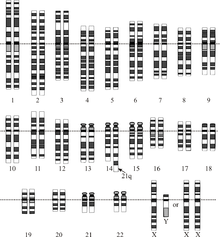Robertsonian translocation is a common form of chromosomal rearrangement that occurs in the five acrocentric human chromosome pairs, namely 13, 14, 15, 21, and 22. They are named after the American insect geneticist W. R. B. Robertson, who first described a Robertsonian translocation in grasshoppers in 1916. They are also called whole-arm translocations or centric-fusion translocations. They are a type of chromosomal translocation.
Consequence
A Robertsonian translocation is a type of nonreciprocal translocation in which two nonhomologous acrocentric chromosomes (chromosomes that are not members of the same pair and have centromeres near their ends) break at their centromeres. The long arms may become attached to a single centromere and serve a function. The short arms also join to form a reciprocal product, which typically contains nonessential genes and is usually lost within a few cell divisions.
In humans, when a Robertsonian translocation joins the long arm of chromosome 21 with the long arm of chromosome 14 (or 15), the heterozygous carrier is phenotypically normal because there are two copies of all major chromosome arms and hence two copies of all essential genes. However, the progeny of this carrier may inherit an unbalanced trisomy 21, causing Down Syndrome.
About one in a thousand newborns has a Robertsonian translocation. The most frequent forms of Robertsonian translocations are between chromosomes 13 and 14, 13 and 21, and 21 and 22, and occur when the long arms of two acrocentric chromosomes fuse at the centromere and the two short arms are lost.
A Robertsonian translocation in balanced form results in no excess or deficit of genetic material and causes no health difficulties. In unbalanced forms, Robertsonian translocations cause chromosomal deletions or addition and result in syndromes of multiple malformations, including trisomy 13 (Patau syndrome) and trisomy 21 (Down syndrome).
A Robertsonian translocation results when the long arms of two acrocentric chromosomes fuse at the centromere and the two short arms are lost. In this case, the long arms of chromosomes 13 and 14 have fused, but no genetic material was lost - this person is completely normal despite the translocation. Common Robertsonian translocations are confined to the acrocentric chromosomes 13, 14, 15, 21 and 22, because the short arms of these chromosomes encode for rRNA which is present in multiple copies.
People with Robertsonian translocations have only 45 chromosomes in each of their cells, yet all essential genetic material is present, and they appear normal. Their children, however, may either be normal and carry the fusion chromosome (depending which chromosome is represented in the gamete), or they may inherit a missing or extra long arm of an acrocentric chromosome. Genetic counseling and genetic testing is offered to families that may be carriers of chromosomal translocations.












No comments:
Post a Comment